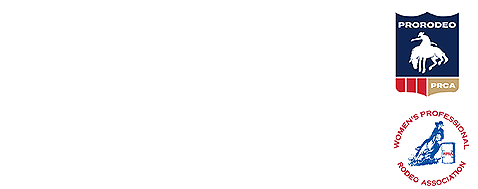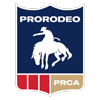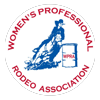PRCA Rodeo Professionals & Athletes

Cowboys, Cowgirls & Livestock
PRCA Rodeo Events In Every Performance
Each rodeo competitor must be a member of the Pro Rodeo Cowboys Association (PRCA) or the Women’s Pro Rodeo Association (WPRA), the “NFL” of rodeo. Each year, cowboys and cowgirls compete at numerous rodeos throughout the U.S., earning points and prize money in hopes of making it to the National Finals Rodeo held in Las Vegas annually in December. Only the top 15 competitors, the best of the best, earn the chance to compete at the National Finals.
However, it is not all about the cowboys and cowgirls. A rodeo would not be complete without the animal athletes. Horses, horses and more horses; well trained and true athletes in their own right, these icons of the west carry their riders through a variety of events such as calf roping, team roping, steer wrestling, steer roping and barrel racing. These animals are owned and cared for by their riders.
Cowboys test their skills on wild bucking horses and ferocious bulls, also known as “rough stock” hoping to “hang on” for that magic eight second ride. Like the rodeo athletes, rough stock also earns the right to perform at the National Finals. Again, only the best of the best move up. These valuable animals are owned and cared for by a certified stock contractor.
The names of cowboys and cowgirls who have registered to compete in this year’s Cave Creek Rodeo Days Rodeo will be provided when available. In the meantime, check out the biographies of competitors on the PRCA Website.

Bareback Bronc
Cowboys ride untrained horses with no saddle or rein. They sit ‘bareback’ and hold tight to a leather rigging that looks like a heavy piece of rope with a suitcase handle on the end. The cowboys ride one handed and cannot touch their body or the horse with the free hand. The cowboys spur the horse between shoulder and rigging, keeping in rhythm with the horse and trying for a qualifying ride of 8 seconds. Cowboys are judged on their control and spurring technique while the horses are judged on power, speed, and agility.
Team Roping
In team roping, each cowboy has a different objective. As with other timed rodeo events, team ropers start from the roping box. The first cowboy out of the box, the header, does just what the name implies and ropes the head of the steer. Once the catch is made the header dallies, or wraps his rope around his saddle horn and turns the steer to the left. The second cowboy, the heeler, ropes the “heels” (back legs). The clock is stopped when ropes are tight, the steer is “stretched” and the horses are facing each other with their front feet on the ground.
Steer Wrestling
Also known as bulldogging, Steer Wrestling is the quickest of the rodeo events. It requires strength, speed and timing. Cowboys compete against the clock and each other. Like tie-down and team ropers, bulldoggers begin in the roping box. When the cowboy nods his head the steer is released from the chute and off to the races they go, cowboy and horse chasing down the steer. The cowboy catches up to the steer as quickly as possible, leans off his horse and grabs the steer by its head. As he slides off his saddle, the bulldogger plants his feet and wrestles the steer to the ground. The clock stops when the steer is on its side.
Saddle Bronc
Considered rodeo’s “classic event”. It requires the use of a specialized association saddle with free-swinging stirrups and no horn. The rider grips a single bronc rein braided from cotton or polyester and attached to a leather halter worn by the horse. The rider lifts the rein, attempting to find a rhythm with the animal by spurring forwards and backwards, reaching from the shoulder of the animal back to the cantle of the saddle. At no time can he touch the horse or himself with his free arm or hand. He cannot switch the rein to the other hand or lose a stirrup. As with bareback bronc riding, the mark out rule is in effect and an 8 second ride is required.
Tie-down Roping
Tie-down ropers compete against each other and the clock for prize money. Like steer wrestlers and team ropers, tie-down ropers begin in the roping box. The calf is released from a chute and the cowboy must rope it as quickly as possible. As soon as the catch is made the cowboy dismounts, sprints to the calf and tosses it on its side (called flanking). Using a small rope known as a pigging string, usually held in the cowboy’s teeth, any three of the calf’s legs are then securely tied. Time stops when the cowboy throws up his hands.
Barrel Racing
Barrels are set up at three specific arena locations. Cowgirls enter the arena at full speed, quickly rounding each barrel in a cloverleaf pattern and then exiting the arena where they entered. An electronic timer records the ride to a hundredth of a second. Because speed equates to a winning time, riders steer their horses as close to the barrels as possible, attempting to shave precious seconds off the clock.
Breakaway Roping
Breakaway roping is a variation of calf roping where a calf is roped, but not thrown and tied. A light rope is fastened from the chute to the calf’s neck, releasing once the calf is well away from the chute and releasing the barrier, which is used to ensure that the calf gets a head start. Once the barrier has released, the horse runs out of the box while the roper attempts to throw a lasso around the neck of the calf. Once the rope is around the calf’s neck, the roper signals the horse to stop suddenly. The rope is tied to the saddle horn with a string. When the calf hits the end of the rope, the rope is pulled tight and the string breaks. The breaking of the string marks the end of the run. The fastest run wins.
Bull Riding
Perhaps the most recognized and popular of all rodeo events. It is also the most dangerous. With bull riding, the cowboys always say “it’s not if you get hurt, but when”. Every bull rider can attest to the truth behind that saying. As with bareback and saddle bronc riding, bull riders hang on with one hand and cannot touch the bull or their body with their free hand. Doing so results in a “no score”. To ride, cowboys use a bull rope and rosin.
Bareback Bronc
Cowboys ride untrained horses with no saddle or rein. They sit ‘bareback’ and hold tight to a leather rigging that looks like a heavy piece of rope with a suitcase handle on the end. The cowboys ride one handed and cannot touch their body or the horse with the free hand. The cowboys spur the horse between shoulder and rigging, keeping in rhythm with the horse and trying for a qualifying ride of 8 seconds. Cowboys are judged on their control and spurring technique while the horses are judged on power, speed, and agility.
Team Roping
In team roping, each cowboy has a different objective. As with other timed rodeo events, team ropers start from the roping box. The first cowboy out of the box, the header, does just what the name implies and ropes the head of the steer. Once the catch is made the header dallies, or wraps his rope around his saddle horn and turns the steer to the left. The second cowboy, the heeler, ropes the “heels” (back legs). The clock is stopped when ropes are tight, the steer is “stretched” and the horses are facing each other with their front feet on the ground.
Steer Wrestling
Also known as bulldogging, Steer Wrestling is the quickest of the rodeo events. It requires strength, speed and timing. Cowboys compete against the clock and each other. Like tie-down and team ropers, bulldoggers begin in the roping box. When the cowboy nods his head the steer is released from the chute and off to the races they go, cowboy and horse chasing down the steer. The cowboy catches up to the steer as quickly as possible, leans off his horse and grabs the steer by its head. As he slides off his saddle, the bulldogger plants his feet and wrestles the steer to the ground. The clock stops when the steer is on its side.
Saddle Bronc
Considered rodeo’s “classic event”. It requires the use of a specialized association saddle with free-swinging stirrups and no horn. The rider grips a single bronc rein braided from cotton or polyester and attached to a leather halter worn by the horse. The rider lifts the rein, attempting to find a rhythm with the animal by spurring forwards and backwards, reaching from the shoulder of the animal back to the cantle of the saddle. At no time can he touch the horse or himself with his free arm or hand. He cannot switch the rein to the other hand or lose a stirrup. As with bareback bronc riding, the mark out rule is in effect and an 8 second ride is required.
Tie-down Roping
Tie-down ropers compete against each other and the clock for prize money. Like steer wrestlers and team ropers, tie-down ropers begin in the roping box. The calf is released from a chute and the cowboy must rope it as quickly as possible. As soon as the catch is made the cowboy dismounts, sprints to the calf and tosses it on its side (called flanking). Using a small rope known as a pigging string, usually held in the cowboy’s teeth, any three of the calf’s legs are then securely tied. Time stops when the cowboy throws up his hands.
Barrel Racing
Barrels are set up at three specific arena locations. Cowgirls enter the arena at full speed, quickly rounding each barrel in a cloverleaf pattern and then exiting the arena where they entered. An electronic timer records the ride to a hundredth of a second. Because speed equates to a winning time, riders steer their horses as close to the barrels as possible, attempting to shave precious seconds off the clock.
Breakaway Roping
Breakaway roping is a variation of calf roping where a calf is roped, but not thrown and tied. A light rope is fastened from the chute to the calf’s neck, releasing once the calf is well away from the chute and releasing the barrier, which is used to ensure that the calf gets a head start. Once the barrier has released, the horse runs out of the box while the roper attempts to throw a lasso around the neck of the calf. Once the rope is around the calf’s neck, the roper signals the horse to stop suddenly. The rope is tied to the saddle horn with a string. When the calf hits the end of the rope, the rope is pulled tight and the string breaks. The breaking of the string marks the end of the run. The fastest run wins.
Bull Riding
Perhaps the most recognized and popular of all rodeo events. It is also the most dangerous. With bull riding, the cowboys always say “it’s not if you get hurt, but when”. Every bull rider can attest to the truth behind that saying. As with bareback and saddle bronc riding, bull riders hang on with one hand and cannot touch the bull or their body with their free hand. Doing so results in a “no score”. To ride, cowboys use a bull rope and rosin.




